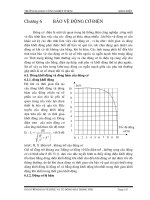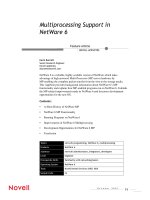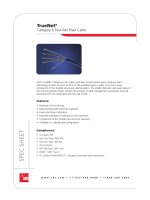Tài liệu học về Vyatta NAT 6 5r1 v01
Bạn đang xem bản rút gọn của tài liệu. Xem và tải ngay bản đầy đủ của tài liệu tại đây (643.52 KB, 89 trang )
Vyatta
Suite200
1301ShorewayRoad
Belmont,CA94002
vyatta.com
6504137200
1888VYATTA1(USandCanada)
VYATTA,INC. | VyattaSystem
NAT
REFERENCEGUIDE
NAT
COPYRIGHT
Copyright©2005–2012Vyatta,Inc.Allrightsreserved.
Vyattareservestherighttomakechangestosoftware,hardware,anddocumentationwithoutnotice.Forthemostrecentversionof
documentation,visittheVyattawebsiteatvyatta.com.
PROPRIETARYNOTICES
VyattaisaregisteredtrademarkofVyatta,Inc.
Hyper‐VisaregisteredtrademarkofMicrosoftCorporation.
VMware,VMwareESX,andVMwareserveraretrademarksofVMware,Inc.
XenServer,andXenCenteraretrademarksofCitrixSystems,Inc.
Allothertrademarksarethepropertyoftheirrespectiveowners.
RELEASEDATE:October2012
DOCUMENTREVISION.6.5R1
v01
RELEASEDWITH:6.5R1
PARTNO.A0‐0230‐10‐0013
iii
NAT 6.5R1v01 Vyatta
Contents
QuickListofCommands......................................................... v
ListofExamples ...............................................................vi
Preface. ..................................................................... vii
IntendedAudience ................. ................... ..........................................viii
OrganizationofThisGuide ........... .......
................................. .....................viii
DocumentConventions ............................................
............... ................ix
VyattaPublicati ons.................
................................ .. ................. ...........ix
Chapter1NATOverview........................................................ 1
WhatisNAT? .............................................. .. ................. ................... 2
BenefitsofNAT ............
...................................................................... 3
TypesofNAT ...........................
.........................................................4
SourceNAT(SNAT)..........................................
................................. .5
DestinationNAT(DNAT).............
................................. .........................5
BidirectionalNAT .........................................
....................................6
InteractionBetweenNAT,Routing,Firewall,andDNS .......
............... ................... .........7
InteractionBetweenNATandRouting ..
.........................................................7
InteractionBetweenNATandFirewall .......................................
...................10
InteractionBetweenNATandDNS ........................ ..
................................. ..13
NATRules ...... ........
................................. .................... ................... 13
TrafficFilters ......................... .
............... ................... .................... ...14
The“outbound‐interface”Filter ................................... ......
.......................14
The“inbound‐interface”Filter.......................
..........................................14
The“protocol”Filter .....
................................. ...................................15
The“source”Filter ................ ..............
................................ .. ...........15
The“destination”Filter ...
............... ................... ..................................16
AddressConversion:“Translatio n”Addresses.............................
...........................16
SourceAddressTranslations ...... ...............
................................. .............16
DestinationAddressTranslations ..
.............................................................17
Chapter2NATConfigurationExamples........................................... 18
SourceNAT(One‐to‐One)............... .. ........................................................19
SourceNAT(Man y‐to‐One) ...................
................................. ...................20
SourceNAT(Man y‐to‐Many).............. .............................
...........................22
SourceNAT(One‐to‐Many) ..................
................................ .. ................. ..23
iv
NAT 6.5R1v01 Vyatta
Masquerade....................................................... .............................25
DestinationNAT(One‐to‐One).............
................................. .......................27
DestinationNAT(One‐to‐Many) .......................................
............... .............29
BidirectionalNAT.....................
.................................................... .......31
MappingAddressRanges.. .....................................
..................................32
The“exclude”Option.............
.................................... ...........................34
SourceNATandVPN:Usingthe“exclude”Option............. .................
............... ........35
TheNegationOperator ......... ................
............... ................... ................37
Chapter3NATCommands ..................................................... 40
clearnat<rule‐type>counters ...... ................... ........................................42
monitornat<rule‐type>background............................
................................43
monitornat<rule‐type>rule<rule‐num> ..... .......
................................. ...........44
monitornat<rule‐type>translations..
..........................................................45
nat .............................. .. ..........
............... ...............................47
nat<rule‐type>rule
<rule‐num> ...............................................................48
nat<rule‐type>rule<rule‐num>description<desc> .............................
..................50
nat<rule‐type>rule<rule‐num>destination .........................
............................52
nat<rule‐type>rule<rule‐num>disable ................
................................. ........54
nat<rule‐type>rule<rule‐num>exclude ..
................................. .....................56
nat<rule‐type>rule<rule‐num>inbound‐interface<interface> .....................................
58
nat<rule‐type>rule<rule‐num>log<state> .. ................... ................... ..
...........60
nat<rule‐type>rule<rule‐num>outbound‐interface<interface>..............................
......62
nat<rule‐type>rule<rule‐num>protocol<protocol> .....................................
.........64
nat<rule‐type>rule<rule‐num>source..................................
............... ........66
nat<rule‐type>rule<rule‐num>translation.....................
............... ..................68
shownat<rule‐type>rules .............
............... ................... .....................70
shownat<rule‐type>statistics..........................................
.......................72
shownat<rule‐type>translations ......................
................................. .......73
GlossaryofAcronyms.......................................................... 75
v
NAT 6.5R1v01 Vyatta
QuickListofCommands
Use this list to help you quickly locate commands.
clearnat<rule‐type>counters........................................ .. ................. ..........42
monitornat<rule‐type>background .......................
................................. .......43
monitornat<rule‐type>rule<rule‐num>....
................................. .................... ...44
monitornat<rule‐type>translations ........................ ...............
........................45
nat<rule‐type>rule<rule‐num>description<desc>...................
................................50
nat<rule‐type>rule<rule‐num>destination .. .. ........
................................ .. ...........52
nat<rule‐type>rule<rule‐
num>disable.............................................................54
nat<rule‐type>rule<rule‐num>exclude................................
............................56
nat<rule‐type>rule<rule‐num>inbound‐interface<interface>.............
............................58
nat<rule‐type>rule<rule‐num>log<state> ............ ..
................................. ..........60
nat<rule‐type>rule<rule‐num>outbound
‐interface<interface>..................... ................... 62
nat<rule‐type>rule<rule‐num>protocol<protocol>..
................................. ...............64
nat<rule
‐type>rule<rule‐num>source ........................................ .. ................. ..66
nat<rule‐type>rule<rule‐num>translation ............................
.............................68
nat<rule‐type>rule<rule‐num>...............
............... ................... ..................48
nat............... .. ................................
................................. ..........47
shownat<rule‐type>rules...
.....................................................................70
shownat<rule‐type>statistics ..........................
............... ................... ........72
shownat<rule‐type>translations ....
............... ...............................................73
vi
NAT 6.5R1v01 Vyatta
ListofExamples
Use this list to help you locate examples you’d like to look at or try.
Example1‐1CreatingasourceNAT(SNAT)rule.......................................... ............14
Example1‐2 Settingtheoutboundinterface ..................................
.......................14
Example1‐3 Settingtheinboundinterface......................
................................. ...14
Example1‐4 Filteringpacketsbyprotocol .........
................................. .................15
Example
1‐5 Filteringpacketsbysourceaddress....... ..............................................15
Example1‐6 Filteringpacketsbysourcenetworkaddressandport................................
......15
Example1‐7 Filteringpacketsbydestinationaddress......................................
...........16
Example1‐8 SettingasourceIPaddress........................ .........
............... ............16
Example1‐9 SettingarangeofsourceIPaddresses ...............
....................................17
Example1‐10 SettingasourceIPaddresstothatoftheoutboundinterface..
............... ..............17
Example1‐11 SettingadestinationIPaddress...............
............... ................... ......17
Example1‐12 SettingarangeofdestinationIPaddresses ..
............................................17
Example2‐14 MultiplesourceNATrulesusing
thenegationoperator:unexpec tedbehavior .................38
Example3‐3DisplayingsourceNATruleinformation ......................
............................71
Example3‐4DisplayingsourceNATstatisticsinformation ................
..............................72
vii
NAT 6.5R1v01 Vyatta
Preface
This document describes the various deployment, installation, and upgrade options
for Vyatta software.
This preface provides information about using this guide. The following topics are
presented:
• Intended Audience
• Organization of This Guide
• Document Conventions
• Vyatta Publications
IntendedAudience
viii
NAT 6.5R1v01 Vyatta
IntendedAudience
This guide is intended for experienced system and network administrators.
Depending on the functionality to be used, readers should have specific knowledge
in the following areas:
• Networking and data communications
• TCP/IP protocols
• General router configuration
• Routing protocols
• Network administration
• Network security
• IP services
OrganizationofThisGuide
This guide has the following aid to help you find the information you are looking for:
• Quick List of Commands
Use this list to help you quickly locate commands.
• List of Examples
Use this list to help you locate examples you’d like to try or look at.
This guide has the following chapters:
Chapter Description Page
Chapter 1:NATOverview Thischapterexplainshowtosetupnetwork
addresstranslation(NAT)ontheVyatta
System.
1
Chapter 2:NATConfiguration
Examples
Thischapterprovidesconfigurationexamples
forusi ngnetworkaddresstranslation(NAT)
ontheVyattasystem.
18
Chapter 3:NATCommands Thischapterdescribesnetworkaddress
translation(NAT)commands.
40
GlossaryofAcronyms 75
DocumentConventions
ix
NAT 6.5R1v01 Vyatta
DocumentConventions
This guide uses the following advisory paragraphs, as follows.
NOTENotesprovideinformationyoumightneedtoavoidproblemsorconfigurationerrors.
This document uses the following typographic conventions.
VyattaPublications
WARNINGWarningsalertyoutosituationsthatmayposeathreattopersonalsafety.
CAUTIONCautionsalertyoutosituationsthatmightcauseharmtoyoursystemordamageto
equipment,orthatmayaffectservice.
Monospace
Examples, command-line output, and representations of
configuration nodes.
boldMonospace
Your input: something you type at a command line.
bold Commands, keywords, and file names, when mentioned
inline.
Objects in the user interface, such as tabs, buttons, screens,
and panes.
italics An argument or variable where you supply a value.
<key> A key on your keyboard, such as <Enter>. Combinations of
keys are joined by plus signs (“+”), as in <Ctrl>+c.
[ key1 | key2] Enumerated options for completing a syntax. An example is
[enable | disable].
num1–numN A inclusive range of numbers. An example is 1–65535, which
means 1 through 65535, inclusive.
arg1 argN A range of enumerated values. An example is eth0 eth3,
which means eth0, eth1, eth2, or eth3.
arg[ arg ]
arg[,arg ]
A value that can optionally represent a list of elements (a
space-separated list and a comma-separated list, respectively).
VyattaPublications
x
NAT 6.5R1v01 Vyatta
Full product documentation is provided in the Vyatta technical library. To see what
documentation is available for your release, see the Guide to Vyatta Documentation.
This guide is posted with every release of Vyatta software and provides a great
starting point for finding the information you need.
Additional information is available on www.vyatta.com and www.vyatta.org.
1
NAT 6.5R1v01 Vyatta
Chapter1:NATOverview
This chapter explains how to set up network address translation (NAT) on the Vyatta
System.
This chapter presents the following topics:
• What is NAT?
• Benefits of NAT
• Types of NAT
• Interaction Between NAT, Routing, Firewall, and DNS
• NAT Rules
• Traffic Filters
• Address Conversion: “Translation” Addresses
Chapter1:NATOverview WhatisNAT?
2
NAT 6.5R1v01 Vyatta
WhatisNAT?
Network Address Translation (NAT) is a service that modifies address and/or port
information within network packets as they pass through a computer or network
device. The device performing NAT on the packets can be the source of the packets,
the destination of the packets, or an intermediate device on the path between the
source and destination devices.
Figure1‐1AnexampleofadeviceperformingNetworkAddressTranslation(NAT)
NAT was originally designed to help conserve the number of IP addresses used by the
growing number of devices accessing the Internet, but it also has important
applications in network security.
The computers on an internal network can use any of the addresses set aside by the
Internet Assigned Numbers Authority (IANA) for private addressing (see also RFC
1918). These reserved IP addresses are not in use on the Internet, so an external
machine will not directly route to them. The following addresses are reserved for
private use:
• 10.0.0.0 to 10.255.255.255 (CIDR: 10.0.0.0/8)
• 172.16.0.0 to 172.31.255.255 (CIDR: 172.16.0.0/12)
• 192.168.0.0 to 192.168.255.255 (CIDR: 192.268.0.0/16)
To this end a NAT-enabled router can hide the IP addresses of an internal network
from the external network, by replacing the internal, private IP addresses with public
IP addresses that have been provided to it. These public IP addresses are the only
addresses that are ever exposed to the external network. The router can manage a
pool of multiple public IP addresses, from which it can dynamically choose when
performing address replacement.
Be aware that, although NAT can minimize the possibility that internal computers
make unsafe connections to the external network, it provides no protection to a
computer that, for one reason or another, connects to an untrusted machine.
Therefore, you should always combine NAT with packet filtering and other features
of a complete security policy to fully protect your network.
Internal (trusted) network
External (untrusted) network
IP Packet
Dest-addr = 12.34.56.78
IP Packet
Dest-addr = 10.0.0.4
NAT
Chapter1:NATOverview BenefitsofNAT
3
NAT 6.5R1v01 Vyatta
BenefitsofNAT
NAT confers several advantages:
• NAT conserves public Internet address space.
Any number of hosts within a local network can use private IP addresses, instead
of consuming public IP addresses. The addresses of packets that are transmitted
from this network to the public Internet are translated to the appropriate public
IP address. This means that the same private IP address space can be re-used
within any number of private networks, as shown in Reusing private address
space Figure 1-2.
Figure1‐2Reusingprivateaddressspace
• NAT enhances security.
IP addresses within a private (internal) network are hidden from the public
(external) network. This makes it more difficult for hackers to initiate an attack
on an internal host. However, private network hosts are still vulnerable to attack,
and therefore NAT is typically combined with firewall functionality.
Internet
10.0.0.0/8
10.0.0.0/8
10.0.0.0/8
10.0.0.0/8
Chapter1:NATOverview TypesofNAT
4
NAT 6.5R1v01 Vyatta
Figure1‐3NATcombinedwithfirewall
• NAT is seamless.
Standard client/server network services work without modification through a
NAT-enabled device.
• NAT facilitates network migration from one address space to another.
The address space within a NATted private network is independent of the public
IP address. This means that the private network can be moved to a new public IP
address without changing network configurations within the private network.
Likewise, the addressing within the private network can change without affecting
the public IP address.
• NAT simplifies routing.
NAT reduces the need to implement more complicated routing schemes within
larger local networks.
TypesofNAT
There are three main types of NAT:
• Source NAT. This is also called SNAT. “Masquerade” NAT is a special type of
SNAT.
• Destination NAT. This is also called DNAT.
• Bidirectional NAT. When both SNAT and DNAT are configured, the result is
bidirectional NAT.
Internal (trusted) networkExternal (untrusted ) network
Routing Table
10.x.x.x not listed
Internet
Hacker
87.65.43.21
Secret Workstation
10.0.0.99
?
No Route
Chapter1:NATOverview TypesofNAT
5
NAT 6.5R1v01 Vyatta
SourceNAT(SNAT)
Tip:SNATis
performed
afterthe
routing
decisionis
made.
SNAT is the most common form of NAT. SNAT changes the source address of the
packets passing through the Vyatta system. SNAT is typically used when an internal
(private) host needs to initiate a session to an external (public) host; in this case, the
NATting device changes the source host’s private IP address to some public IP
address, as shown in Figure 1-4. In “masquerade” NAT (a common type of SNAT),
the source address of the outgoing packet is replaced with the primary IP address of
the outbound interface. The destination address of return packets is automatically
translated back to the source host’s IP address.
The NATting device tracks information about the traffic flow so that traffic from the
flow can be correctly forwarded to and from the source host.
Figure1‐4SourceNAT(SNAT)
DestinationNAT(DNAT)
Tip:DNATis
performed
beforethe
routing
decisionis
made.
While SNAT changes the source address of packets, DNAT changes the destination
address of packets passing through the Vyatta system. DNAT is typically used when
an external (public) host needs to initiate a session with an internal (private) host; for
example, when a subscriber accesses a news service, as shown in Figure 1-5. The
source address of return packets is automatically translated back to the source host’s
IP address.
Internal (trusted) network
External (untrusted) network
Source-addr = 12.34.56.78
Dest-addr = 96.97.98.99
Source-addr = 10.0.0.4
Dest-addr = 96.97.98.99
SNAT
Chapter1:NATOverview TypesofNAT
6
NAT 6.5R1v01 Vyatta
Figure1‐5DestinationNAT(DNAT)
BidirectionalNAT
Bidirectional NAT is just a scenario where both SNAT and DNAT are configured at
the same time. Bidirectional NAT is typically used when internal hosts need to
initiate sessions with external hosts AND external hosts need to initiate sessions with
internal hosts. Figure 1-6 shows an example of bidirectional NAT.
Figure1‐6BidirectionalNAT
Internal (trusted) network
External (untrusted) network
Source-addr = 96.97.98.99
Dest-addr = 12.34.56.78
Source-addr = 96.97.98.99
Dest-addr = 10.0.0.4
DNAT
Internal (trusted) network
External (untrusted) network
Source-addr = 12.34.56.78
Source-addr = 10.0.0.4
SNAT
Dest-addr = 12.34.56.78
Dest-addr = 10.0.0.4
DNAT
Chapter1:NATOverview InteractionBetweenNAT,Routing,Firewall,andDNS
7
NAT 6.5R1v01 Vyatta
InteractionBetweenNAT,Routing,Firewall,
andDNS
One of the most important things to understand when working with NAT is the
processing order of the various services that might be configured within the Vyatta
system. If processing order is not considered, the results achieved may not be as
intended.
For example, if you are using DNAT you should take care not to set up the system
to route packets based on particular external addresses. This routing method would
not have the intended result, because the addresses of external packets would have
all been changed to internal addresses by DNAT prior to routing.
Figure 1-7 shows the traffic flow relationships between NAT, routing, and firewall
within the Vyatta system.
Figure1‐7TrafficflowsthroughtheVyattasystem
InteractionBetweenNATandRouting
When considering NAT in relation to routing, it is important to be aware how
routing decisions are made with respect to DNAT and SNAT. The scenarios in this
section illustrate this point.
Scenario1a:DNAT—Pack etsPassingThroughtheVyattaSystem
In this scenario, packets are originated in Network A and pass through the Vyatta
system. Note the following:
DNAT
Firewall
(name,
in)
Routing
Vyatta system
Dest =
Local?
No
Firewall
(name,
local)
Yes
SNAT
Firewall
(name,
out)
Local
Process
Routing
Network A Network B
Chapter1:NATOverview InteractionBetweenNAT,Routing,Firewall,andDNS
8
NAT 6.5R1v01 Vyatta
Tip:DNAT—rou
tingdecisions
arebasedon
translated
destination
address.
DNAT operates on the packets prior to the routing decision. This means that routing
decisions based on the destination address are made relative to the translated
destination address—not the original destination address; see Figure 1-8.
Figure1‐8Pass‐throughDNATroutingdecisions
Scenario1b:DNAT—PacketsDestinedfortheVyattaSystem
The same is true for packets destined for the Vyatta system itself. In this scenario,
packets are destined for a process within the Vyatta system.
Again, because DNAT operates on the packets prior to the routing decision, routing
decisions based on destination address are made on the translated destination
address—not the original destination address; see Figure 1-9.
DNAT
Firewall
(name,
in)
Routing
Vyatta system
Dest =
Local?
No
Firewall
(name,
local)
Yes
SNAT
Firewall
(name,
out)
Local
Process
Routing
Network A Network B
Dest-addr = 12.34.56.78
Dest-addr = 10.0.0.4
Chapter1:NATOverview InteractionBetweenNAT,Routing,Firewall,andDNS
9
NAT 6.5R1v01 Vyatta
Figure1‐9Vyattasystem‐destinedDNATroutingdecisions
Scenario2a:SNAT—PacketsPassingThroughtheVyattaSystem
Tip:SNAT
routing
decisionsare
basedon
originalsource
address.
On the other hand, routing decisions are made prior to SNAT. This means that
routing decisions based on source address are made on the original source
address—not the translated source address; see Figure 1-10.
Figure1‐10Pass‐throughSNATroutingdecisions
DNAT
Firewall
(name,
in)
Routing
Vyatta system
Dest =
Local?
No
Firewall
(name,
local)
Yes
SNAT
Firewall
(name,
out)
Local
Process
Routing
Network A Network B
Dest-addr = 12.34.56.78
Dest-addr = 10.0.0.20
DNAT
Firewall
(name,
in)
Routing
Vyatta system
Dest =
Local?
No
Firewall
(name,
local)
Yes
SNAT
Firewall
(name,
out)
Local
Process
Routing
Network A Network B
Src-addr = 12.34.56.78
Src-addr = 10.0.0.4
Chapter1:NATOverview InteractionBetweenNAT,Routing,Firewall,andDNS
10
NAT 6.5R1v01 Vyatta
Scenario2b:SNAT—PacketsOriginatingFromtheVyattaSystem
In this scenario, packets are originated by a process within the Vyatta system.
Again, because routing decisions are made prior to SNAT, operations based on
source address are made on the original source address—not the translated source
address; see Figure 1-11.
Figure1‐11Vyattasystem‐originatedSNATroutingdecisions
InteractionBetweenNATandFirewall
When considering NAT in relation to the firewall, it is important to understand the
traffic flow relationship between NAT and firewall. In particular, it is important to
keep in mind that firewall rule sets are evaluated at different points in the traffic
flow. The scenarios in this section illustrate this point.
Scenario1a:DNAT—Pack etsPassingThroughtheVyattaSystem
In this scenario, packets are originated in Network A and pass through the Vyatta
system. Note the following:
For firewall rule sets applied to inbound packets on an interface, the firewall rules
are applied after DNAT (that is, on the translated destination address).
For rule sets applied to outbound packets on an interface, the firewall rules are
applied after DNAT (that is, on the translated destination address); see Figure 1-12.
DNAT
Firewall
(name,
in)
Routing
Vyatta system
Dest =
Local?
No
Firewall
(name,
local)
Yes
SNAT
Firewall
(name,
out)
Local
Process
Routing
Network A Network B
Src-addr = 12.34.56.78
Src-addr = 10.0.0.20
Chapter1:NATOverview InteractionBetweenNAT,Routing,Firewall,andDNS
11
NAT 6.5R1v01 Vyatta
Figure1‐12Pass‐throughDNATfirewalldecisions
Scenario1b:DNAT—PacketsDestinedfortheVyattaSystem
In this scenario, packets are destined for a process within the Vyatta system. When
firewall rule sets are applied to locally bound packets on an interface, the firewall
rules are applied after DNAT (that is, on the translated destination address); see
Figure 1-13.
Figure1‐13Vyattasystem‐destinedDNATfirewalldecisions
DNAT
Firewall
(name,
in)
Routing
Vyatta system
Dest =
Local?
No
Firewall
(name,
local)
Yes
SNAT
Firewall
(name,
out)
Local
Process
Routing
Network A Network B
Dest-addr = 12.34.56.78
Dest-addr = 10.0.0.4
DNAT
Firewall
(name,
in)
Routing
Vyatta system
Dest =
Local?
No
Firewall
(name,
local)
Yes
SNAT
Firewall
(name,
out)
Local
Process
Routing
Network A Network B
Dest-addr = 12.34.56.78
Dest-addr = 10.0.0.20
Chapter1:NATOverview InteractionBetweenNAT,Routing,Firewall,andDNS
12
NAT 6.5R1v01 Vyatta
Scenario2a:SNAT—PacketsPassingThroughtheVyattaSystem
Tip:SNAT
firewallrules
areappliedon
originalsource
address.
Firewall rules are applied prior to SNAT. This means that firewall decisions based on
source address are made on the original source address—not the translated source
address. This order of evaluation is true for both inbound and outbound packets;
see Figure 1-14.
Figure1‐14Pass‐throughSNATfirewalldecisions
Scenario2b:SNAT—PacketsOriginatingFromtheVyattaSystem
In this scenario, packets are originated by a process within the Vyatta system.
Firewall rule sets are not involved.
DNAT
Firewall
(name,
in)
Routing
Vyatta system
Dest =
Local?
No
Firewall
(name,
local)
Yes
SNAT
Firewall
(name,
out)
Local
Process
Routing
Network A Network B
Src-addr = 12.34.56.78
Src-addr = 10.0.0.4
Chapter1:NATOverview NATRules
13
NAT 6.5R1v01 Vyatta
Figure1‐15Vyattasystem‐originatedSNATfirewalldecisions
InteractionBetweenNATandDNS
NAT and DNS can be combined in various scenarios involving load balancing. These
can include additional load-balancing switches that operate at higher protocol layers
(Layers 4 through 7). For example, a large bank may have many web servers with
transactions load-balanced across them.
In these cases the NAT configuration must be carefully considered to achieve the
desired results. Discussion of DNS and load-balancing scenarios is beyond the scope
of this chapter.
NATRules
NAT is configured as series of NAT “rules”. Each rule instructs NAT to perform a
network address translation that you require. NAT rules are numbered, and are
evaluated in numerical order. The NAT rule number can be changed using the
rename and copy commands.
NOTEChangestoNATrulesaffectonlyconnectionsestablishedafterthechangesaremade.Those
connectionsthatarealreadyestablishedatthetimeachangeismadearenotaffected.
Tip:Leavea
gapbetween
NATrule
numbers.
It is advisable to create your NAT rules leaving “space” between the numbers. For
example, you might initially create your set of NAT rules numbered 10, 20, 30, and
40. This way, if you need to insert a new rule later on, and you want it to execute in
a particular sequence, you can insert it between existing rules without having to
change any other rules.
DNAT
Firewall
(name,
in)
Routing
Vyatta system
Dest =
Local?
No
Firewall
(name,
local)
Yes
SNAT
Firewall
(name,
out)
Local
Process
Routing
Network A Network B
Src-addr = 12.34.56.78
Src-addr = 10.0.0.20
Chapter1:NATOverview TrafficFilters
14
NAT 6.5R1v01 Vyatta
The Vyatta system allows you to configure source NAT ( SNAT), or destination NAT
rules. To implement bidirectional NAT, you define a NAT rule for SNAT and one for
DNAT. Example 1-1 defines an SNAT rule 10.
Example1‐1CreatingasourceNAT(SNAT)rule
vyatta@vyatta#setnatsourcerule10
TrafficF ilters
Filters control which packets will have the NAT rules applied to them. There are five
different filters that can be applied within a NAT rule: outbound-interface,
inbound-interface, protocol, source, and destination.
The“outbound‐interface”Filter
The outbound-interface filter is applicable only to source NAT (SNAT) rules. It
specifies the outbound traffic flow that the NAT translation is to be applied to.
Example 1-2 sets SNAT rule 20 to apply a NAT translation to outbound traffic on
interface eth1.
Example1‐2Settingtheoutboundinterface
vyatta@vyatta#setnatsourcerule20outbound‐interfaceeth1
The“inbound‐interface”Filter
The inbound-interface filter is applicable only to destination NAT (DNAT) rules. It
specifies the inbound traffic flow that the NAT translation is to be applied to.
Example 1-3 sets DNAT rule 20 to apply NAT rules to inbound traffic on interface
eth0.
Example1‐3Settingtheinboundinterface
vyatta@vyatta#setnatdestinationrule20inbound‐interfaceeth0
Chapter1:NATOverview TrafficFilters
15
NAT 6.5R1v01 Vyatta
The“protocol”Filter
The protocol filter specifies which protocol types the NAT translation will be applied
to. Only packets of the specified protocol are NATted. The default is all protocols.
The protocol filter can be used in SNAT and DNAT rules.
Example 1-4 sets SNAT rule 10 to apply to TCP protocol packets. Only TCP packets
will have address translation performed.
Example1‐4Fi lteringpacketsbyprotocol
vyatta@vyatta#setnatsourcerule10protocoltcp
The“source”Filter
The source filter specifies which packets the NAT translation will be applied to,
based on their source address and/or port. Only packets with a source address and/or
port matching that defined in the filter are NATted.
If the source filter is not specified, then by default, the rule matches packets arriving
from any source address and port. The source filter can be used in SNAT and DNAT
rules.
Example 1-5 sets SNAT rule 10 to apply to packets with a source address of 10.0.0.4.
Only packets with a source address of 10.0.0.4 will have address translation
performed.
Example1‐5Fi lteringpacketsbysourceaddress
vyatta@vyatta#setnatsourcerule10sourceaddress10.0.0.4
Example 1-6 sets SNAT rule 20 to apply to packets with a source network of
10.0.0.0/24 and port 80. Only packets with a source address on the 10.0.0.0/24
subnet with a source port of 80 will have address translation performed.
Example1‐6Fi lteringpacketsbysourcenetworkaddressandport
vyatta@vyatta#setnatsourcerule20sourceaddress10.0.0.0/24
vyatta@vyatta#setnatsourcerule20sourceport80









